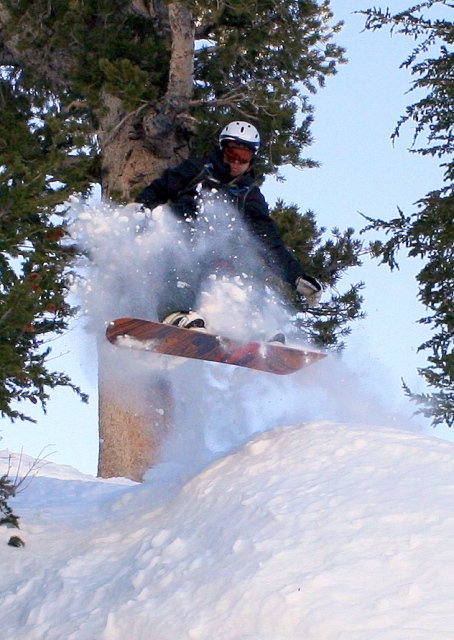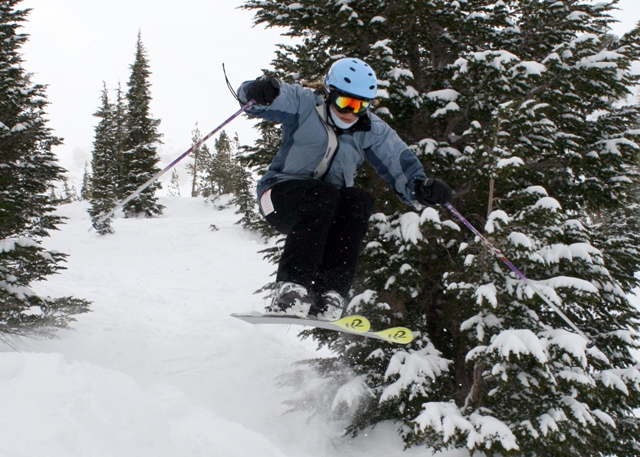 MaxWettsteinFitness.com!
MaxWettsteinFitness.com!Time to Hit the Slopes! Getting Fit for Downhill Skiing & Boarding is Critical.
copyright Max Wettstein 2013, **not medical advice
Snow skiing & snowboard season is
officially upon us! Mammoth Mountain just opened. It’s time to tune and
sharpen your boards as well as your fitness, if you want maximize your potential
for fun while minimizing your risk for injury. Make no mistake: downhill alpine
riding is very high-intensity and very demanding physically, and will test every
measure of your fitness. Trust me, you don’t want to roll up to the slopes on
day one of the season totally out of shape and collapse into oxygen debt just
getting all your gear on, suffer from low-back spasms on the morning of day two,
or worse yet, rupture a knee ligament on your “last run” of the day. So take
precaution and action now! Pay your dues in these next few weeks leading up to
your first trip to the slopes and not only will you avoid injury but you’ll
actually be fit enough to enjoy riding the mountain, instead of just suffering
through a half day on the slopes, just to make it to the lodge and start downing
beers by lunch. Fellas we indeed have to earn that post-ski beer and it will
taste so much better! And even if you are in good shape right now with a
respectable fitness level, it still will make your mountain experience more
rewarding if you add some sport-specific exercises into your routine that mimic
the movements and intensity level of riding the bumps, carving the groomers, or hucking your favorite cliff.
Downhill skiing and snowboarding are very high-intensity activities, inherently performed in interval-style, anaerobic, eccentric-contraction, lactic-acid-producing, near-maximum-effort bouts, immediately followed by stagnant, chilling lift-line waits and chairlift rides back up, usually in a cold, high-altitude climate. By the time you unload from the chair-lift you could already be stiffening up and chilled to the core. So much for keeping your muscles and ligaments warm and pliable! Dressing appropriately for the extreme range of motion and climate conditions goes without saying, and although it is beyond the scope of this article, your apparel and gear choices can make or break your day on the slopes in a matter of minutes. You can never really be too prepared, even riding inside the patrolled, groomed boundary lines. Everyone intends to ride terrain that suits their own ability but, it’s still a very dynamic sport that most of us rarely do, in challenging outdoor terrain and in shifting weather conditions that we’re not often exposed too. And let’s face it, most of the time we end up riding with a group of friends of mixed abilities and mixed egos. You just might happen to be the weak link, pushed to ride beyond your ability by your hooligan mates! While we cannot completely physiologically prepare for the elevation change until we actually relocate to the mountains, there is plenty we can do to prepare the rest of our fitness.
As you may have already deduced from the preceding paragraph, the best way to prepare for downhill alpine riding is by applying a High-Intensity Interval Training strategy, known simply as HIIT for short. HIIT style training targets both anaerobic (lactic-acid producing) cardio and strength fitness, possesses high exercise value (greater fitness stress in shorter period of time), and conveniently can be done almost anywhere there is a hill, stair case, treadmill or spin-bike, using only your own bodyweight, so it is very practical. HIIT style workouts typically last only 30 to 40 minutes, including a 10 minute warm-up and 10 minute cool-down, and are performed in a 1:3 interval ratio, of 1 minute of maximum-effort working interval immediately followed by 3 minutes of resting interval, repeated for 20 minutes. Key word being, ‘maximum-effort’, which means during the working-interval you’re pushing yourself predominantly into the anaerobic energy system, huff and puff, oxygen-debt, lactic-acid burning zone, all the way to near-failure! You can motivate to reach this intensity level knowing you only have to maintain it for 1 minute, before getting to rest for 3 minutes. Think about how long your typical bout of downhill riding lasts before you either pause on the run to collect your buddies, hit lactic-acid accumulation (i.e. quad-burning) failure, or reach the bottom of the slope – this is typically about one minute of skiing. This type of HIIT training also does wonders for your general fitness level too, not to mention post-workout, metabolism-boosting fat-burning potential, but I won’t get into that here. Just know with HIIT style training, (good) pain on the working-interval does equal big gains, yielding high exercise value and over time you will raise your lactate-threshold, improving your anaerobic stamina. The working interval is typically accomplished by running up a hill or staircase, or sprinting a lap around the track, or sprinting uphill on a bike. The resting interval is accomplished simply by walking back down the same hill or staircase, ideally while wearing a heart rate monitor to realistically know where you stand in your recovery, and to validate your exertion perception. This HIIT workout should ideally be performed 2 to 3 days per week, spaced out respectively evenly between your other workouts
On your other training days you will ideally add in a day of, lower-body/legs’ strength training to include alternating lunges, squats and stiff-legged deadlifts. These exercises are going to strengthen the muscles surrounding your knee joints, building rock solid joint integrity, and boost your overall leg strength to meet the physical demands of downhill riding and alpine-terrain negotiation. Perform them using a weight that allows at least 15 repetitions and perform 3 sets each, even if this means using only your own body weight. Good form is paramount above all else, so save your ego for the mountain. Seriously - getting injured in the controlled, training environment of the gym is not only lame, it is stupid. These aforementioned exercises are also going to strengthen your glutes, lower-back muscles and core, which are absolutely critical in allowing you to withstand the downward sloping impacts and repeated eccentric contractions of absorbing moguls, terrain obstacles, checking off too much speed in the steeps, and the high G-force loading experienced during power carving.
On your remaining three days of the week, I recommend incorporating one day of plyometric, callisthenic and agility style training, to include movements like box-jumps, broad-jumps, high-knee skips, trampoline work, agility ladder or cone patterns, and burpees. On another day, I recommend a longer, slower, endurance type of jog, hike or bike ride, to also work on your aerobic fitness, which will help you acclimate more quickly to the elevation by producing more red blood cells, and if you decide to hike for some untracked fresh snow, you’ll be relying on your aerobic capacity to get you there. On your last day of the week you have an optional rest-day, a free-sport day, or, if you happen to also still care about your upper body fitness and physique you should use this final day to strength-train your upper body. On your free-sport day, you could think about adding in some roller-blading if you’re a skier and some skateboarding if you’re a boarder to mimic the same movements on flat-land. Seriously, there is a big cross-over benefit.
Though we can’t actually prevent altitude sickness, and while some of us will inherently be more susceptible to experiencing it than others through no fault of our own, heading up the hill already fit and healthy, will highly decrease your risk. Remember also that dehydration is more common at elevation, especially when you’re first acclimating and that alcohol and caffeine will tend to compound this issue since they are diuretics. Dehydration will increase risk and severity of altitude sickness symptoms. Also, rarely does anyone sleep soundly during their first few nights up in elevation, which can also add to the risk of altitude sickness. Ingesting 200 mg of NSAID Ibuprofen or the like, before going to bed may help prevent or minimize altitude sickness or the symptoms according to some mountain guides & ski-patrol. Drinking extra water is essential too! Time permitting, some light stretching and/or foam-rolling is highly recommended in the morning before your first run. Consider wearing some wicking-type, compression-wear as your first-layer to enhance performance. Even applying a hot-pack to your lower-back could help get the circulation going. And if possible choose a run that is mellower for you for that first run of the day and give your back, knees and core a chance to loosen up and warm up! By the time you take two chair-lifts to get to the top, you will certainly be on the cold side making you more prone to injury. Recognize your fatigue too, and call it day before you think you’ve hit your limit! Chances are most of your buddies will already be in the lodge with a beer waiting for you!
Links: Back to Max's Training Page! Back to Max's Home Page!